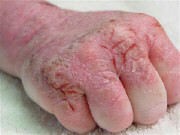'via Blog this'Some cases of self-diagnosed Morgellons disease are actually other recognized skin disorders, including allergic dermatitis, contact dermatitis, idiopathic urticaria and infestation with the parasite scabies. There are also case reports of patients submitting self-dissected superficial nerves.[3] [54][65]
[edit]Hypotheses about the fibers
Randy Wymore, a former research director of the MRF and presently director of the Oklahoma State University Center for Health Sciences' Center for the Investigation of Morgellons Disease, claims that Morgellons patients have submitted masses of dark fibers visible at 60x magnification under the unbroken skin, while unaffected individuals do not.[3] Wymore sent samples of fibers, none of which was collected by biopsy, to the Police Crime Lab in Tulsa, Oklahoma, for analysis. A forensic scientist at the Tulsa Police Crime Lab in Oklahoma searched the FBI's national database, but the Morgellons sample did not match any known fiber in the database.[11] Lab director Mark Boese said the fibers were "consistent with something that the body may be producing," adding, "These fibers cannot be manmade and do not come from a plant. This could be a byproduct of a biological organism."[11]
Conversely, in Wymore's further studies of the fibers, none of the samples he has sent to the laboratory have been unusual. Laboratory results have included nylon, cotton, human hair, a fungal fiber and a rodent hair.[66]
Dermatologists say many fibers are from clothing embedded in self-imposed sores and the fibers patients bring in bags are textile in nature.[13][67] The fibers may also be peripheral nerve endings.[65]
The signs and symptoms furthermore are similar to chronic fatigue syndrome, depressive disorders and other maladies. A number of healthcare professionals believe that the fibers are textiles which come from the patients’ very own clothing as they try to scratch and gouge out the source of the infestation within their skin. Others are convinced that the fibers could be nerve endings or the legs of mites. Others believe the fibers are the byproducts of a bacterium that attacks plants, or that they’re something which the body is producing on its own.
Other healthcare professionals pin the blame on pesticides and various other toxins on the symptoms endured by the patients. There are dermatologists who, when dealing with a patient with Morgellons, believe the affected person is delusional and treat them with antipsychotic drugs such as pimozide. This drug also treats the patient’s symptom of itching. Some other doctors use the same antibiotic treatments that are used to treat chronic Lyme disease with Morgellons patients.
A number of sufferers, confronted with the disbelief of physician after physician and no medical health insurance, turn to hazardous methods to cure themselves of Morgellons.
Morgellons is a multi-symptom disease that is just now starting to be researched and understood. It has a number primary symptoms:
- Sponanteously Erupting Skin lesions
- Sensation of crawling, biting on and under the skin
- Appearance of blue, black or red fibers and granules beneath and/or extruding from the skin
- Fatigue
- Short-term memory loss
- Attention Deficit, Bipolar or Obsessive-Compulsive disorders
- Impaired thought processing (brain fog)
- Depression and feelings of isolation
It is frequently misdiagnosed as Delusional Parasitosis or an Obsessive Picking Disorder.
Where
- Most cases in the United States are from specific geographic regions of California, Texas and Florida, though all 50 states have had reported cases.
- Oklahoma has reported numerous probable cases.
- It has been reported worldwide in places such as Europe, South Africa, Japan, The Philippines, Indonesia and Australia
There are doctors who believe it is related to an infectious agent, perhaps in the same family as that which causes Lyme Disease. There is no evidence to prove this theory at the present time.
- Attention needs to be drawn to Morgellons so:
- Doctors will become informed and make accurate diagnoses
- Insurance companies will cover medical expenses
- Major government organizations (the CDC, for example) will pay attention and start funding research
Copyright © Oklahoma State Universit
Government stonewalls investigation

Morgellons fibers all have one thing in common -- they appear to originate in the skin lesions of their victims. But individually they are quite different in both appearance and composition. There are fuzzy white fibers, sometimes called "cotton balls", that are found growing on top of the skin lesions. Then there are the colored fibers or threads, usually pink, blue or black, that are found under the skin -- even in the surrounding healthy tissue -- and often poke through the lesions. Then there are clear fibers that have a small golden bulb on the end.
It's alive!
Electron microscopy of the Morgellons filaments reveals that they are not simple solid forms, rather, they are complex structures with internal structures. In some laboratory experiments these fibers have been shown to re-assemble when they are separated, to squirm and pulsate and even to reproduce.In the images above we see [A] a 1400x maginfication of some of the fibers collected from a Morgellons lesion. Next [B] is the same specimen maginfied 5600x. The last [C] shows what appears to be a bud forming on the side of a filament (5600x).
"Budding" structures are apparent on the sides of the fiber at occasional locations. The budding structures contain internal structures at the roughly micron or sub-micron size. Budding structures also often contain innumerable filaments within, measuring apparently at the sub-micron level (Limit of equipment reached). Reproduction and growth of the primary fiber structure may be closely linked to these budding structures. The budding structures generally appear to be quite complex in form, structure and organization.




No comments:
Post a Comment